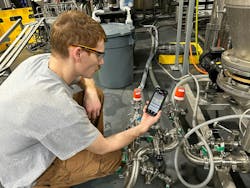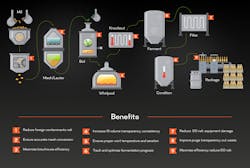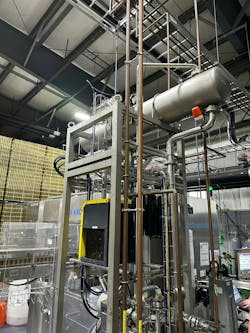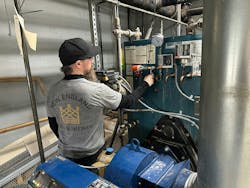How automation enhances performance of critical brewery equipment
Beverage manufacturers rely on critical equipment such as chillers, boilers, compressors and pumps to keep their operations running efficiently. Condition monitoring sensors are essential for maintaining these utilities, ensuring continuous and reliable support for production processes. More importantly, the continuous measurement of process parameters, such as pH, dissolved oxygen, turbidity and density, is vital for maintaining the quality and consistency of the produced product. Additionally, monitoring critical sanitation tasks, such as the clean-in-place (CIP) processes of equipment, helps enhance overall operational efficiency and sustainability.
For instance, pressure and condensate level sensors in a boiler enable operators to react quickly to potential failures before they affect the production process. By identifying issues early, these sensors prevent the complete loss of steam, which would otherwise result in costly downtime and potentially lost products.
Continuous monitoring of dissolved oxygen levels is crucial to detect any leaks in the system that could compromise the final product quality. For example, a leak introducing excess oxygen can lead to oxidation, which adversely affects the taste and stability of the beverage. Real-time oxygen monitoring helps maintain the desired product quality and consistency.
The use of conductivity sensors to measure the conductivity of CIP chemicals and rinse water can significantly reduce waste and enhance sustainability. By accurately determining when to stop the rinse water, these sensors ensure that only the necessary amount is used, thereby saving water and reducing operational costs.
With the simplicity of just one sensor, installed in minutes, manufacturers can automate critical equipment and start receiving real-time data instantly. This data provides actionable insights to enhance productivity, quality and sustainability. Automation is revolutionizing beverage production by improving product quality while making facilities more efficient, nimble, and flexible.
How sensor technology improves the brewing processes
The brewing process involves a delicate and intricate series of steps that demand precise control and optimization to produce high-quality beer. Sensor technology enhances performance at every stage of this process.
1. The mill process reduces the risk of foreign contaminants
In a brewery, the mill grinds raw materials such as malted barley and other grains into grist. Sensors measure and monitor the particle size of ground malt to ensure consistency in grist composition, directly impacting mash efficiency and lautering performance. Additionally, sensors monitor the flow rate of grain into the mill and control the feed rate to prevent overfeeding or underfeeding.
Integrated sensor systems interface with automated control systems to regulate milling parameters based on real-time sensor readings. By automating controls, consistency is improved as mill settings are adjusted dynamically, optimizing energy usage and reducing operator intervention.
Excessive heat generation during milling can affect the flavor of the beer. Sensors help maintain the temperature within safe limits to preserve malt quality. They also monitor conditions such as vibration levels, bearing temperatures and motor currents, making the process safer for both equipment and workers. Moreover, sensors can detect foreign contaminants such as metal, ensuring that the grist remains pure and free from harmful particles.
2. The mash/lauter process ensures accurate mash conversion
In a brewery, lautering is the process of separating the wort (mash) from the residual grain as efficiently as possible. Simply put, the mash/lauter process converts starches from malted grains into fermentable sugars by separating the liquid wort from the spent grain.
Sensor technology can monitor temperatures and activity levels during this process — helping brewers maintain consistency and quality. It can provide insights into how the equipment is operating and how it compares batches consistently.
During this process, pH sensors measure the acidity of the mash. Monitoring pH ensures that enzymatic activity is maximized, leading to efficient sugar extraction and optimal wort composition, as well as maintaining the grain-to-water ratio.
Some advanced brewing systems use sensors to monitor time and temperature profiles throughout the mash process. Sensors provide real-time data to ensure adherence to mash schedules and to optimize enzymatic activity. Automated control enhances consistency, efficiency and repeatability in the mash/lauter process, reducing manual intervention and optimizing resource usage.
3. The boiling process maximizes brewery consistency
One of the most critical components in this process is the steam boiler — which plays a vital role in providing the necessary heat and steam required for various stages of brewing. The boiler is responsible for heating water and creating steam, which is essential for flavor development, hop utilization and sterilization of the wort.
Sensors monitor the temperature of the wort during boiling. Maintaining precise control over boiling temperatures is crucial for achieving optimal flavor extraction from hops, as different hop compounds are released at specific temperature ranges. Sensors help brewers adjust heating intensity to achieve desired rolling boils and prevent wort scorching.
Some brewing systems use sensors to monitor the intensity of the boil, which affects evaporation rates, hop utilization efficiency and protein coagulation. Sensors provide real-time feedback to optimize energy usage and maintain consistent boil conditions.
Sensors connected to the boiler can provide actionable data about hop addition timings, evaporation rate control, foam control and recipe specifications.
Some breweries use sensors to monitor the addition of fining agents, flavorings or other additives during boiling. This ensures accurate dosing and integration of these ingredients into the wort, enhancing beer clarity, flavor and stability. Sensors also contribute to safety by preventing overheating of the wort and ensuring that equipment operates within safe limits. Sensors may also monitor vessel pressures to prevent over-pressurization during boiling.
4. The whirlpool process increases fill volume transparency and consistency
Sensors are used to monitor the temperature during the whirlpool stage to ensure that the beer is maintained at the optimal temperature for the whirlpool process, which typically ranges from 80°C to 90°C. Sensors help maintain consistency and ensure that the beer achieves proper protein coagulation and hop utilization.
Sensors can also be used to monitor the duration of the whirlpool process. This ensures that the beer is exposed to the whirlpool action for the correct amount of time, which is essential for achieving the desired clarity and separating trub (coagulated proteins and hop residues) from the wort.
Sensor technology can measure the clarity of the wort during the whirlpool process. This allows brewers to adjust the whirlpool time or other parameters if the turbidity levels are not optimal, ensuring that the wort is clear before it proceeds to the next stage of brewing.
In some advanced brewing systems, pressure and flow sensors are used to control the movement of wort during the whirlpool process. Integrated sensor systems can be part of automated brewing systems, where sensors feed real-time data to control systems that adjust parameters such as temperature, flow rates and timing. This level of automation improves consistency and repeatability in the whirlpool process.
5. The knockout process ensures proper wort temperature and aeration
During the knockout process, temperature sensors are used to monitor the incoming and outgoing temperature levels that affect the efficiency of the heat exchanger.
As with other brewing processes, temperature monitoring plays a role as the wort exits the heat exchanger. The wort needs to be rapidly cooled from boiling temperatures to fermentation temperatures (typically around 20°C -25°C for ales and slightly lower for lagers). Sensors ensure that the wort is cooled efficiently and precisely to prevent off-flavors and to achieve optimal yeast pitching temperatures.
Maintaining a consistent flow rate is important for controlling the cooling process and ensuring that the wort is cooled uniformly. Sensors help brewers adjust cooling parameters as needed to achieve the desired rate of cooling while sensor technology monitors the pressure in the wort lines during knockout to maintain proper flow and prevent issues such as cavitation or blockages that can affect the efficiency of the cooling process.
Automated adjustments can be made based on real-time readings from temperature, flow and pressure sensors. Automated control ensures that the knockout process is consistent and repeatable, leading to predictable brewing outcomes.
6. The fermentation process tracks and optimizes fermentation progress
Sensors are crucial for monitoring and maintaining the fermentation temperature. Different yeast strains have specific temperature ranges at which they perform best, influencing both flavor profile and fermentation chemistry. Sensors ensure that the fermentation vessel remains within the desired temperature range, either through manual adjustments or automated control systems.
Sensors are used to monitor the specific gravity (SG) or density of the fermenting beer. This allows brewers to track the progress of fermentation by measuring the decrease in SG as sugars are converted into alcohol and carbon dioxide.
In addition, pH sensors monitor the acidity of the fermenting beer. Yeast health and fermentation activity are influenced by pH, so maintaining the correct pH range is important for achieving consistent fermentation performance and flavor development. In pressure fermentation or closed fermentation systems, sensors monitor the internal pressure of the fermenter to control the fermentation environment and influence yeast behavior and beer carbonation levels.
Sensors are used to monitor dissolved oxygen levels in the fermenting beer. Controlling oxygen exposure is critical to prevent oxidation, which can lead to off-flavors and aroma compounds
7. The filter process reduces dissolved oxygen (DO) and equipment damage risks
The filter, generally a centrifuge, ensures that oxygen does not enter at that point of the process. Sensor technology protects this very expensive piece of equipment and monitors operating behaviors like vibration. Automation can alert operators before catastrophic failures happen.
Sensor technology monitors the flow rates of beer and filtration aids through the filtration system. Maintaining a consistent flow rate is important for efficient filtration and achieving desired throughput without compromising beer quality.
Controlling pressure is critical for ensuring proper filtration efficiency and preventing filter clogging or breakthrough. Sensors help maintain optimal pressure conditions throughout the filtration process.
Sensor technology can detect particles or haze in the beer as it passes through the filter and provide real-time feedback on the clarity of the beer — which helps determine when to stop the filtration process.
While filtration typically happens at cold temperatures to enhance clarity and reduce haze, sensors ensure that the beer remains within the optimal temperature range to maintain product quality. Sensor technology provides real-time monitoring of filtration parameters and automated adjustments based on sensor data feedback.
8. The conditioning process enhances clarity and reduces waste
The conditioning process in beer brewing, often referred to as maturation or aging, is where the beer undergoes secondary fermentation and conditioning to develop its final flavor profile, carbonation level and overall stability.
Sensor technology is crucial for monitoring and controlling the temperature of the conditioning tanks or vessels. Different beer styles and yeast strains may require specific temperature profiles during conditioning to achieve desired flavors and aromas. Sensors ensure that the beer is maintained within the optimal temperature range, typically cooler than primary fermentation temperatures but above freezing.
Sensors are used to measure the level of dissolved carbon dioxide (CO2) in the beer during conditioning. Carbonation levels greatly influence taste and perceived quality of the beer. Sensors help brewers achieve precise carbonation levels by monitoring CO2 absorption and ensuring that the beer reaches the desired level of carbonation before packaging. Sensors monitor the pressure inside the conditioning vessels and help brewers maintain the correct pressure conditions to promote proper carbonation and prevent over-pressurization that could lead to packaging issues or safety concerns.
Some advanced conditioning processes may include pH sensors to monitor acidity levels and flavor development during aging. Monitoring pH helps brewers ensure consistency and quality in the final product. Minimizing oxygen exposure is crucial to prevent oxidation, which can lead to off-flavors and reduced shelf life.
9. The packaging process maximizes efficiency and reduces DO risk
When packaging beer, oxygen must be controlled before the can is sealed. Sensor technology dials in precisely where air leaks may be evident. Sensors are used to monitor the volume of beer filled into bottles, cans or kegs. They ensure accurate filling to the specified level, minimizing product waste and ensuring consistency across packages. Sensors help maintain product quality and prevent underfilling or overfilling, which can affect carbonation levels and consumer satisfaction.
It is also important to monitor the level of dissolved CO2 in the beer during packaging to maintain the correct carbonation levels specified for each beer style. Sensor technology monitors the pressure inside packaging vessels (e.g., kegs or cans) during filling and sealing. Sensors help ensure that packaging pressures are within safe and optimal ranges to avoid leaks, spoilage or packaging failures.
Sensors ensure accurate positioning of labels and printing of batch codes, best-before dates, and other information required by regulatory standards.
Why automation matters in the beer brewing process
Automation ensures that each batch of beer is brewed with the same precise measurements, timings and conditions as previous batches. This consistency is crucial for maintaining the flavor, quality and safety of the beer. Automated systems can perform tasks more quickly and accurately than humans, leading to increased production rates and reduced downtime.
Sensor technology optimizes the use of raw materials and energy, further reducing expenses in modern breweries. It also allows breweries to scale their operations more easily. As demand grows, automated systems can be expanded or upgraded to handle increased production without a proportional increase in labor costs.
Most important, sensor technology collects detailed data on every aspect of the brewing process. This data can be analyzed to identify trends, troubleshoot problems and continuously improve the brewing process while providing precise control over the brewing parameters such as temperature, pressure and timing. This level of control is difficult to achieve manually and is essential for producing high-quality beer.
BrewOps
About the Author
Aaron Ganick
Founder and CEO of Preddio Technologies, the parent company of BrewOps.
Aaron Ganick is a serial technology entrepreneur and the founder and CEO of Preddio Technologies, the parent company of BrewOps. Aaron holds a degree in electrical engineering from Boston University and has authored dozens of granted patents in the fields of optical networking, telecommunications and automation systems. He can be reached at [email protected]. For more information on BrewOps, the fast and easy-to-install brewery automation platform, visit www.brewops.com.



